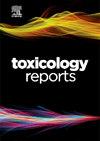UHPLC-QTOF-MS/MS profiling, molecular networking, and molecular docking analysis of Gliricidia sepium (Jacq.) Kunth. ex. Walp. stem ethanolic extract and its gastroprotective effect on gastritis in rats
Q1 Environmental Science
引用次数: 0
Abstract
Metabolic profiling of the crude ethanolic extract of Gliricidia sepium (Jacq.) Kunth. ex. Walp. stem ethanolic extract (GSS) was conducted using ultra-high performance quadrupole time of flight mass spectrometry/mass spectrometry (UHPLC-QTOF-MS/MS) in negative mode, resulting in the identification of 23 compounds belonging to various classes such as flavonoids, fatty acids, triterpenoid saponins, and phenolic acids. Notably, eight flavonoids including kaempferol-3-O-robinoside-7-O-rhamnoside, isoquercitrin, kaempferol-3-O-rutinoside, apigenin-7-glucoside, kaempeferol-7-O-rhamnoside, luteolin, apigenin, and liquiritigenin, along with two phenolic acids (4-hydroxycinnamic acid and 2-hydroxyhydrocinnamic acid) and four triterpenoid saponins (soyasaponin I, soyasaponin II, soyasaponin III, and kaikasaponin III) were dereplicated. Additionally, nine fatty acid derivatives were identified, including azelaic acid and 2-isopropyl malic acid. Molecular networking analysis revealed the formation of clusters among compounds while others do not form clusters. Further analysis indicated that the GSS ethanolic extract exhibited a total phenolic content of 38.78 ± 1.609 µg of gallic acid equivalent/mg and a total flavonoid content of 5.62 ± 0.50 µg of rutin equivalent/mg. Biological evaluations showed that GSS ethanolic extract mitigated gastric tissue injury induced by pyloric ligation, with a notable reduction in oxidative stress marker reactive oxygen species levels and inflammatory cytokines interleukin-6 and tumor necrosis factor-alpha levels. Additionally, it enhanced superoxide dismutase and inhibitor of nuclear factor kappa B alpha levels, while lowering the expression of inducible nitric oxide synthase. Histopathological examination revealed significant improvements in gastric tissue morphology in GSS-treated groups compared to the control group. Molecular docking studies indicated potential interactions between GSS ethanolic extract compounds and various target proteins involved in oxidative stress, inflammation, and gastric protection in gastritis. This study aims to investigate the potential gastroprotective activity of GSS ethanolic extract against gastritis induced via pyloric ligation.
质谱分析、分子网络及分子对接分析肯。Walp。茎乙醇提取物及其对大鼠胃炎的保护作用
水仙花粗醇提取物的代谢谱分析肯。Walp。采用超高效四极杆飞行时间质谱/质谱(UHPLC-QTOF-MS/MS)阴性模式对茎醇提取物(GSS)进行鉴定,鉴定出23种化合物,分别属于黄酮类、脂肪酸类、三萜皂苷类、酚酸类等。值得注意的是,山奈酚-3- o -robinoside-7- o -rhamnoside、异槲皮苷、山奈酚-3- o -rutinoside、芹菜素-7-glucoside、山奈酚-7- o -rhamnoside、木犀草素、芹菜素和甘草素等8种黄酮类化合物,以及2种酚酸(4-羟基肉桂酸和2-羟基氢肉桂酸)和4种三萜皂苷(大豆皂苷I、大豆皂苷II、大豆皂苷III和kaikasaponin III)被去复制。此外,还鉴定出9种脂肪酸衍生物,包括壬二酸和2-异丙基苹果酸。分子网络分析显示化合物之间形成簇,而其他化合物不形成簇。进一步分析表明,GSS乙醇提取物的总酚含量为38.78 ± 1.609 µg没食子酸当量/mg,总黄酮含量为5.62 ± 0.50 µg芦丁当量/mg。生物学评价显示,GSS乙醇提取物可减轻幽门结肠炎引起的胃组织损伤,显著降低氧化应激标志物活性氧水平、炎症因子白介素-6和肿瘤坏死因子- α水平。此外,它还能提高超氧化物歧化酶和核因子κ B α抑制剂的水平,降低诱导型一氧化氮合酶的表达。组织病理学检查显示,与对照组相比,gss治疗组胃组织形态有明显改善。分子对接研究表明,GSS乙醇提取物化合物与胃炎中参与氧化应激、炎症和胃保护的多种靶蛋白之间存在潜在的相互作用。本研究旨在探讨GSS乙醇提取物对幽门结扎引起的胃炎的潜在保护作用。
本文章由计算机程序翻译,如有差异,请以英文原文为准。
求助全文
约1分钟内获得全文
求助全文
来源期刊

Toxicology Reports
Environmental Science-Health, Toxicology and Mutagenesis
CiteScore
7.60
自引率
0.00%
发文量
228
审稿时长
11 weeks
 求助内容:
求助内容: 应助结果提醒方式:
应助结果提醒方式:


